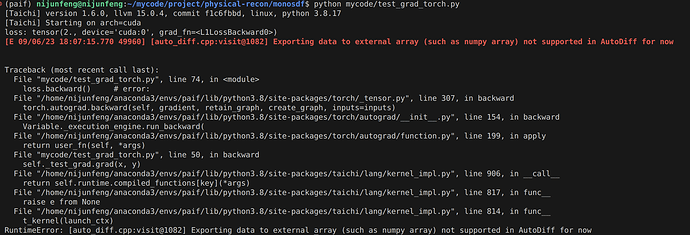大家好!我仿照 taichi-nerfs repo 的 volume_train.py 写了一个简单的结合 taichi 和 pytorch 自动微分的程序,但在反向传播时遇到报错
RuntimeError: [auto_diff.cpp:visit@1082] Exporting data to external array (such as numpy array) not supported in AutoDiff for now
截图如下:
看起来好像是 taichi AutoDiff 不支持 kernel 传入 external array
但是我在运行 taichi-nerfs repo 时并没有遇到这个问题,所以应该是我的代码存在问题,但我并没有发现我相比官方代码有什么区别 [大哭…]
(刚接触taichi,跪求大佬指点
我的代码如下:
import torch
import torch.nn as nn
import numpy as np
import taichi as ti
# init taichi
arch = ti.cuda
ti.init(arch=arch)
@ti.kernel
def test_grad(
x: ti.types.ndarray(),
y: ti.types.ndarray(),
):
for i in range(x.shape[0]):
for j in range(x.shape[1]):
y[i, j] = 3 * x[i, j]
class GradTest(nn.Module):
def __init__(self):
super(GradTest, self).__init__()
self._test_grad = test_grad
class _module_function(torch.autograd.Function):
@staticmethod
def forward(ctx, x):
y = torch.zeros_like(
x,
requires_grad=True
)
self._test_grad(x, y)
ctx.save_for_backward(x, y)
return y
@staticmethod
def backward(ctx, dy):
x, y = ctx.saved_tensors
y.grad = dy
self._test_grad.grad(x, y)
return x.grad
self._module_function = _module_function.apply
def forward(self, x):
return self._module_function(x.contiguous())
if __name__ == "__main__":
x = torch.ones((20, 30), dtype=torch.float32, requires_grad=True).cuda()
grad_test = GradTest()
y = grad_test(x)
L1_loss = nn.L1Loss()
loss = L1_loss(x, y)
print('loss:', loss)
loss.backward() # error: Exporting data to external array (such as numpy array) not supported in AutoDiff for now
print('grad: ', x.grad[0])
官方 volume_train.py 代码如下:
import torch
import taichi as ti
from .utils import torch_type
@ti.kernel
def volume_rendering_kernel(
sigmas: ti.types.ndarray(),
rgbs: ti.types.ndarray(),
deltas: ti.types.ndarray(),
ts: ti.types.ndarray(),
rays_a: ti.types.ndarray(),
T_threshold: float,
T: ti.types.ndarray(),
total_samples: ti.types.ndarray(),
opacity: ti.types.ndarray(),
depth: ti.types.ndarray(),
rgb: ti.types.ndarray(),
ws: ti.types.ndarray()
):
ti.loop_config(block_dim=128)
for n in opacity:
ray_idx = rays_a[n, 0]
start_idx = rays_a[n, 1]
N_samples = rays_a[n, 2]
rgb[ray_idx, 0] = 0.0
rgb[ray_idx, 1] = 0.0
rgb[ray_idx, 2] = 0.0
depth[ray_idx] = 0.0
opacity[ray_idx] = 0.0
total_samples[ray_idx] = 0
T[start_idx] = 1.0
for sample_ in range(N_samples):
s = start_idx + sample_
T_ = T[s]
if T_ > T_threshold:
a = 1.0 - ti.exp(-sigmas[s] * deltas[s])
w = a * T_
rgb[ray_idx, 0] += w * rgbs[s, 0]
rgb[ray_idx, 1] += w * rgbs[s, 1]
rgb[ray_idx, 2] += w * rgbs[s, 2]
depth[ray_idx] += w * ts[s]
opacity[ray_idx] += w
ws[s] = w
T[s+1] = T_ * (1.0 - a)
total_samples[ray_idx] += 1
class VolumeRenderer(torch.nn.Module):
def __init__(self):
super(VolumeRenderer, self).__init__()
self._volume_rendering_kernel = volume_rendering_kernel
class _module_function(torch.autograd.Function):
@staticmethod
def forward(
ctx,
sigmas,
rgbs,
deltas,
ts,
rays_a,
T_threshold
):
ctx.T_threshold = T_threshold
n_rays = rays_a.shape[0]
total_samples = torch.empty_like(rays_a[:, 0])
opacity = torch.empty(
n_rays,
dtype=torch_type,
device=rays_a.device,
requires_grad=True
)
depth = torch.empty(
n_rays,
dtype=torch_type,
device=rays_a.device,
requires_grad=True
)
rgb = torch.empty(
n_rays, 3,
dtype=torch_type,
device=rays_a.device,
requires_grad=True
)
ws = torch.empty_like(
sigmas,
requires_grad=True
)
T_recap = torch.zeros_like(
sigmas,
requires_grad=True
)
self._volume_rendering_kernel(
sigmas,
rgbs,
deltas,
ts,
rays_a,
T_threshold,
T_recap,
total_samples,
opacity,
depth,
rgb,
ws,
)
ctx.save_for_backward(
sigmas,
rgbs,
deltas,
ts,
rays_a,
T_recap,
total_samples,
opacity,
depth,
rgb,
ws,
)
return total_samples.sum(), opacity, depth, rgb, ws
@staticmethod
def backward(
ctx,
dL_dtotal_samples,
dL_dopacity,
dL_ddepth,
dL_drgb, dL_dws
):
# get the saved tensors
T_threshold = ctx.T_threshold
(
sigmas,
rgbs,
deltas,
ts,
rays_a,
T_recap,
total_samples,
opacity,
depth,
rgb,
ws,
) = ctx.saved_tensors
# put the gradients into the tensors before calling the grad kernel
opacity.grad = dL_dopacity
depth.grad = dL_ddepth
rgb.grad = dL_drgb
ws.grad = dL_dws
self._volume_rendering_kernel.grad(
sigmas,
rgbs,
deltas,
ts,
rays_a,
T_threshold,
T_recap,
total_samples,
opacity,
depth,
rgb,
ws,
)
return sigmas.grad, rgbs.grad, None, None, None, None
self._module_function = _module_function.apply
def forward(
self,
sigmas,
rgbs,
deltas,
ts,
rays_a,
T_threshold
):
return self._module_function(
sigmas.contiguous(),
rgbs.contiguous(),
deltas.contiguous(),
ts.contiguous(),
rays_a.contiguous(),
T_threshold,
)
